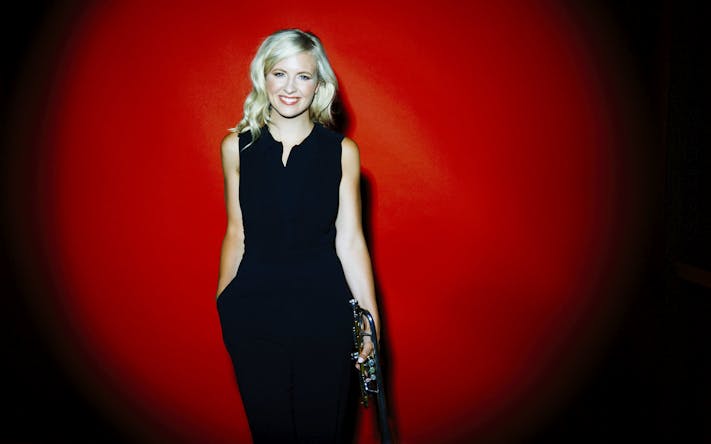The latest of a string of big-name soloists to grace the Sheldonian, Alison Balsom was the draw on Tuesday evening, playing with the Oxford Philharmonic one of the warhorses of the trumpet classical repertoire, Hummel's Trumpet Concerto in E flat major. There was a good-sized audience, and my neighbours from Peru, Sr y Sra (Mr and Mrs) Nicolas Rodriguez, were perhaps representative of many in the audience who were unfamiliar with the piece but keen to see and hear Ms Balsom.
We began with the 29-strong orchestra - no clarinets and no flutes - tackling Haydn's Symphony 44, 'Trauer' ( = 'mourning). Haydn to my mind was overproductive in the symphonic form - there's a suggestion of quantity before quality - but this one's a gem, particularly in its second and third movements: respectively a minuet and an adagio. The former is of a formal, almost severe character, and it was easy to picture, say, the rather priggish Edmund Bertram and Fanny Price from Mansfield Park leading out the local gentry on their eventual wedding day to the strains of this music. Conductor Marios Papadopoulos employed sinuous and sometimes sweeping hand movements here. In the elegiac adagio he twice leaned so far forward from the dais towards the 1st violins and cellos that he appeared almost to be dragging out by hand the notes from their instruments, as a wine connoisseur might lovingly extract the cork from a bottle of 1897 vintage port. This was Haydn at his very best, up there with the glories of his finest choral works.
Mozart's 'Linz' Symphony (No. 36) contains an adagio too, but this one's altogether a freer, more vigorous thing. It provides more evidence, were any needed, that the energy Mozart was able to pack into and then uncoil from a passage of music is deadened not at all by a slackening of tempo. Maestro Papadopoulos greatly contributed to this output of energy by playing up the volatility and suspense by means of clear pauses in the flow. The composer wrote this sunny work in five days after a miserable family reunion, his father disapproving of his wife Constanze. He wrote to his father:
'I have not a single symphony with me so I am writing a new one at breakneck speed.'
Such speed beggars belief, making Handel's feat of writing his Messiah in 20 days seem the work of a snail! In the allegro spiritoso, Mr Papadopoulos led darting thematic and rhythmic charges to push through the orchestra from the double basses upwards, the bassoons always prominent.
Alison Balsom took her place for the Hummel Trumpet Concerto, entering almost unobtrusively despite strong, welcoming applause. With her instrument she cut a striking figure: tall, blonde and in navy blue. As the orchestra launched into its two minutes' introduction, she stood insouciantly, almost casually, and launched herself into the first tune of this sonata-like movement and then its more playful successor. Hummel, a contemporary of both Haydn and Mozart, is a shockingly under-performed composer. Quite why his piano trios and concertos, for instance, are not mainstays in the repertoire is a mystery to me. Hummel means 'bumblebee' in German, though attempts to link his name with his musical style need not detain the rational mind.
Ms Balsom displayed admirable breathing control at the end of the first movement, almost snatching the trumpet away from her lips as though it were red-hot. In the andante her playing was as smooth as buttermilk combined with just an edge of vivacity as she tackled the rising runs and trills near its end, before striding without pause into the rondo with its quasi-hunting calls, conjuring up the hunt careering over hedge and ditch of the Vale of Aylesbury.
A Swedish folk song was offered as an encore before Ms Balsom disappeared as modestly as she had appeared, to unbounded applause.
P.S. For people wanting to dip into the oeuvre of Hummel, I can recommend his First and Second Piano Septets, readily available on CD from Solamente Naturali on the Brilliant Classics label.




